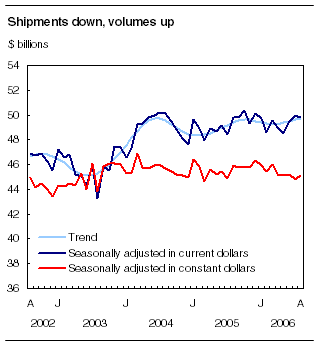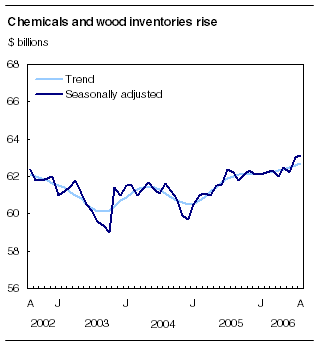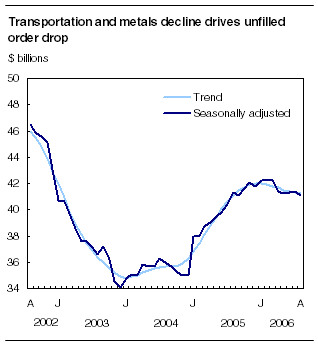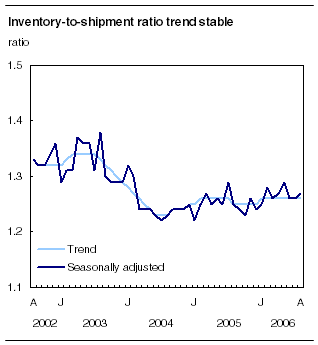Common menu bar links
Monthly Survey of Manufacturing
Archived Content
Information identified as archived is provided for reference, research or recordkeeping purposes. It is not subject to the Government of Canada Web Standards and has not been altered or updated since it was archived. Please "contact us" to request a format other than those available.

Shipments from Canadian factories in August declined slightly from their highest level in 2006. With commodity prices falling the volume of goods shipped actually increased in August.

Canadian manufacturers shipped goods worth $49.8 billion, down 0.3% from July. However, if price declines were taken into account, the overall volume of shipments actually increased 0.5% to $45.0 billion.
Constant dollar shipments (taking price fluctuations into account) in August 2006 were 2.3% lower than they were in August last year, and declined 0.4% when comparing the first eight months of 2006 to the same period in 2005.
Note to readersNon-durable goods industries include food, beverage and tobacco products, textile mills, textile product mills, clothing, leather and allied products, paper, printing and related support activities, petroleum and coal products, chemicals, and plastics and rubber products. Durable goods industries include wood products, non-metallic mineral products, primary metals, fabricated metal products, machinery, computer and electronic products, electrical equipment, appliances and components, transportation equipment, furniture and related products and miscellaneous manufacturing. Unfilled orders are a stock of orders that will contribute to future shipments assuming that the orders are not cancelled. New orders are those received whether shipped in the current month or not. They are measured as the sum of shipments for the current month plus the change in unfilled orders. Some people interpret new orders as orders that will lead to future demand. This is inappropriate since the "new orders" variable includes orders that have already been shipped. Readers should note that the month-to-month change in new orders may be volatile. This will happen particularly if the previous month's change in unfilled orders is closely related to the current month's change. Not all orders will be translated into Canadian factory shipments because portions of large contracts can be subcontracted out to manufacturers in other countries. Also, some orders may be cancelled. |
Shipments decreased in 12 of 21 manufacturing industries in August. Durable goods shipments fell by 1.0% to $26.4 billion, with the transportation sector declining for a second month. Non-durable goods increased by 0.6% to $23.4 billion, thanks to increases in paper, chemicals and food manufacturing. These increases were tempered some by lower shipments from the petroleum industry.
Shipments fall on lower transportation output and petroleum prices
Shipments of transportation equipment fell 1.5% to $9.2 billion. This was the second month of decline as the automotive post-shutdown season started more slowly than usual. Automotive manufacturing shipments fell 1.5% to $4.9 billion as a result of slower vehicle sales. Auto parts shipments were down 1.2% to $2.3 billion.
Falling prices for petroleum and coal products resulted in a decline in shipment value of 2.0% to $5.6 billion, dropping the industry to number three, behind the food industry.
Food manufacturing increased 1.2% to $5.7 billion, making it the second largest industrial sector after transportation, thanks in part to increased production of seafood on the East Coast and beef on the prairies.
Chemicals increased 1.8% to $4.5 billion — the second highest level on record and the highest in 10 months. Shipments of paper products jumped 4.4% to $2.7 billion, the highest level in 2006.
Shipments up in six provinces
Shipments by province showed no strong regional trends with Ontario posting only marginal gains while Quebec shipment levels declined slightly.
In the Atlantic provinces, Newfoundland and Labrador and Prince Edward Island experienced strong increases in shipments, especially in the food industry, while Nova Scotia's shipments increased only slightly. New Brunswick's sharp decline was influenced by lower petroleum prices.
The picture in the West was also varied. Manitoba and Saskatchewan experienced declines while Alberta saw a marginal increase in shipments. British Columbia, on the other hand, saw strong growth on paper products.
Shipments from Quebec declined 1.6% to $11.8 billion, with the largest decrease coming from the primary metals industry followed by petroleum, which fell by 3.0% due to lower prices and volume.

The transportation industry, which accounts for nearly a third of all of Ontario's manufacturing output, decreased 2.0% to $7.6 billion. Automotive manufacturing posted a 1.5% decline to $4.8 billion. Decreases in the transportation and machinery industries largely offset gains in the petroleum (+6.0%), fabricated metals (+4.2%) and primary metals (+3.3%) industries between July and August.
Manitoba's 4.2% decrease in shipments to $1.2 billion was largely due to a decline in the value of shipments in the primary metals industry and also a $7.5 million decline in the value of food shipments. Transportation equipment manufacturing rose by 8.2%, offsetting some of the decline.
Chemical manufacturing posted the strongest gains in Alberta, contributing to a 0.2% increase to $5.7 billion. In spite of weakening oil prices, shipments of petroleum and coal products were the second strongest in Alberta after chemicals.
Shipments from British Columbia increased 4.8% to $3.6 billion largely due to a 17.8% increase in paper shipments to just over a half billion dollars and primary metals, which increased by nearly one-fifth to just under $300 million. Wood product shipments decreased 1.4% to $722 million. Factors such as the protracted softwood lumber dispute, the high exchange rate, the high price of fuel and the decline in housing starts in the United States have meant a 15.8% drop in year-to-date shipments when compared to 2005.
| Manufacturing shipments, provinces and territories | |||||||
|---|---|---|---|---|---|---|---|
| July 2006r | August 2006p | July to August 2006 | |||||
| Seasonally adjusted | |||||||
| $ millions | % change | ||||||
| Canada | 49,973 | 49,842 | -0.3 | ||||
| Newfoundland and Labrador | 160 | 181 | 13.0 | ||||
| Prince Edward Island | 111 | 116 | 4.1 | ||||
| Nova Scotia | 784 | 788 | 0.5 | ||||
| New Brunswick | 1,422 | 1,286 | -9.6 | ||||
| Quebec | 12,014 | 11,823 | -1.6 | ||||
| Ontario | 24,233 | 24,300 | 0.3 | ||||
| Manitoba | 1,300 | 1,245 | -4.2 | ||||
| Saskatchewan | 895 | 873 | -2.5 | ||||
| Alberta | 5,644 | 5,656 | 0.2 | ||||
| British Columbia | 3,402 | 3,567 | 4.8 | ||||
| Yukon | 2 | 2 | 5.7 | ||||
| Northwest Territories including Nunavut | 7 | 6 | -15.6 | ||||
| |||||||
Inventories increase in chemicals and wood products
Manufacturers' total inventories increased by $107 million dollars (+0.2%) to $63.1 billion in August, following a 1.3% rise in July — mainly because of a 2.0% increase in chemical inventories to $7.2 billion and a 1.4% increase to $4.7 billion in wood products.
Transportation inventories declined 1.5% to $8.6 billion, largely as a result of an 8.7% decline in motor vehicle manufacturing and a 1.9% decrease in aerospace products. Inventories of primary metals declined 1.0% to $6.6 billion. Inventory in raw materials and finished products increased while goods in process inventories declined in August.
Transportation leads decline in new orders
New orders declined by 1.1% to $49.5 billion in August.
After quadrupling between April and June of 2006, new orders fell significantly in the aerospace industry for the second straight month, declining by 11.4% to $1.2 billion. In the motor vehicle industry, new orders fell by over a quarter of a billion dollars to $4.7 billion. In total, new orders in the transportation industry declined by $312 million to $9.1 billion. Primary metals experienced the second largest decline (-3.1%) to $4.3 billion while machinery declined by 2.9% to $2.6 billion.
Transportation and primary metals behind drop in unfilled orders
Unfilled orders declined 0.8% to $41.1 billion following two months of small increases (+0.2% for July and +0.4% for June). The transportation industry experienced the largest decrease, falling 0.7% to $20.4 billion. While the aerospace industry rose slightly unfilled orders for motor vehicles drove most of the decline, slipping 15.4% to $1.3 billion.
The primary metals industry was another major contributor to the decline in unfilled orders, falling 4.9% to $2.0 billion in August.

Inventory-to-shipment ratio steady
The inventory-to-shipment ratio increased to 1.27 in August and the finished-product inventory-to-shipment ratio increased to 0.44 from 0.43, while the trend remained stable. The inventory-to-shipment ratio is a key measure of the time, in months, that would be required to exhaust inventories if shipments were to remain at their current level.

Manufacturing employment continues to recede
According to the Labour Force Survey for the month of August, goods-producing industries have continued to be affected by waning foreign demand. Manufacturing employment declined by 11,300 in August, bringing losses to 87,000 since the beginning of 2006.
Manufacturing has been shedding workers since 2002, with August marking the lowest level of employment for this industry since March 1998. Since the start of 2006, manufacturing declines have been widespread, with the largest decreases in food and motor vehicle and parts manufacturing.
Available on CANSIM: tables 304-0014, 304-0015 and 377-0008.
Definitions, data sources and methods: survey number 2101.
All data are benchmarked to the 2004 Annual Survey of Manufactures.
Data from the September Monthly Survey of Manufacturing will be released on November 15.
For general information or to order data, contact the dissemination officer (toll-free 1-866-873-8789; 613-951-9497; fax: 613-951-9499; manufact@statcan.gc.ca). To enquire about the concepts, methods or data quality of the release, contact Daryl Keen (613-951-1810; keendar@statcan.gc.ca), Manufacturing, Construction and Energy Division.


 Table(s).
Table(s).